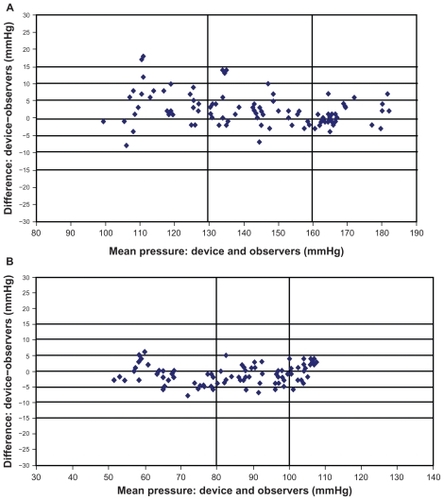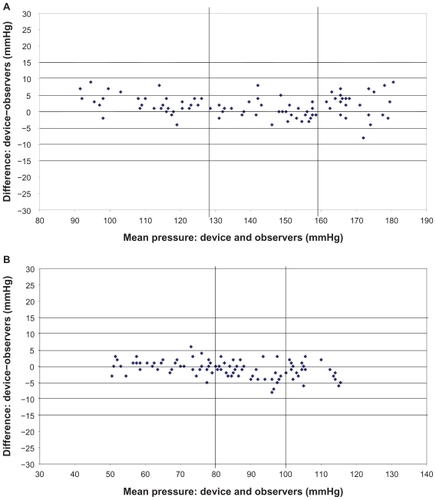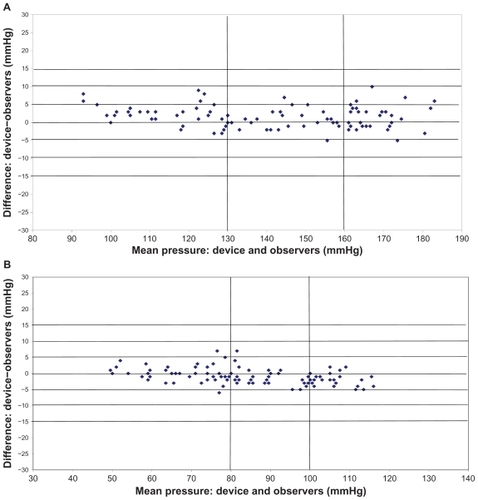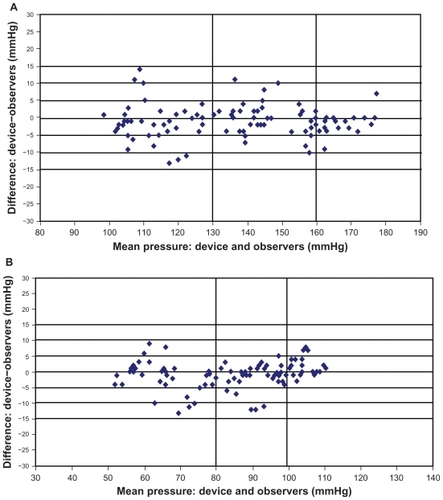Abstract
Background
Four oscillometric devices for self-measurement of blood pressure (SBPM) were evaluated according to the European Society of Hypertension (ESH) international protocol and its 2010 revision in four separate studies. The Omron® M2, Omron M3, and Omron M6 measure blood pressure (BP) at the brachial level, while the Omron R2 measures BP at the wrist level.
Methods
The international protocol requires a total number of 33 subjects in which the validation is performed. The Omron M2 and Omron R2 were validated in 2009 according to the ESH international protocol, while the Omron M3 and Omron M6 were validated in 2010–2011 according to the 2010 ESH international protocol revision. The protocol procedures were followed precisely.
Results
All four tested devices passed the validation process. The mean differences between the device and mercury readings were 2.7 ± 5.0 and −1.4 ± 3.2 mmHg for systolic and diastolic BP, respectively, using the Omron M2 device, and 1.7 ± 3.2 and −0.9 ± 2.6 mmHg using the Omron M3, 1.6 ± 2.9 and −0.9 ± 2.5 mmHg using the Omron M6, and −1.1 ± 4.8 and −0.9 ± 4.3 mmHg using the Omron R2.
Conclusion
Readings from the Omron M2, Omron M3, Omron M6, and Omron R2, differing by less than 5, 10, and 15 mmHg, fulfill the ESH international protocol and its 2010 revision requirements. Therefore, each of these four devices can be used by patients for SBPM.
Introduction
The advantages of blood pressure (BP) self-measurement have been well documented.Citation1,Citation2 Indeed, self-BP measurement (SBPM) not only provides valuable information for diagnosis of hypertension but also for BP control in the treated patient, and improves patient compliance with antihypertensive therapy.Citation1–Citation3 Therefore, it is appropriate to encourage widespread use of SBPM as an important adjunct to the clinical care of patients with hypertension.Citation2 Clinical indications for SBPM have recently been highlighted in several guidelines and consensus conferences.Citation1–Citation6 Obviously, SBPM is only practicably useful if the devices are user-friendly and accurate. Recommended devices for SBPM should be submitted to independent validation procedures. Currently, only a few of the devices available on the market have been validated and are recommended for patient use.Citation7 Validation has to be performed according to recognized protocols specifically designed for this purpose, such as the British Hypertension Society protocol,Citation8 the Association for the Advancement of Medical Instrumentation protocol,Citation9 and the international protocol published by the European Society of Hypertension (ESH).Citation10,Citation11 In this study, four devices for SBPM were validated according to the international protocol in four separate studies.
Methods and materials
Devices
Omron M2
The Omron® M2 (HEM-7117-E) device records brachial BP using the oscillometric method with a pressure range of 0–299 mmHg and pulse rate range of 40–180 beats/minute. Systolic BP, diastolic BP, and pulse rate are displayed on a liquid crystal digital (LCD) screen. The device can detect and display a symbol on the LCD screen if an irregular heart beat defined by a heart beat rhythm that varies by more than 25% from the average heart beat rhythm is detected while the unit is measuring the systolic and diastolic BP. It includes memory for 21 measurements. The unit weighs approximately 260 g without batteries. Four AAA batteries are needed with an approximate capacity of 300 measurements. The standard cuff included is applicable to arm circumferences ranging from 22 to 32 cm; a large cuff is also available for arm circumferences of 32–42 cm.
Omron M3
The Omron M3 (HEM-7200-E) device records brachial BP using the oscillometric method with a pressure range of 0–299 mmHg and pulse rate range of 40–180 beats/minute. Inflation is performed using a fuzzy-logic electric pumping system and deflation by an automatic pressure release valve. At the end of each measurement, systolic BP, diastolic BP, and pulse rate are displayed on a LCD screen. The device can detect and display a symbol on the LCD screen if an irregular heart beat defined by a heart beat rhythm that varies by more than 25% from the average heart beat rhythm is detected while the unit is measuring the systolic and diastolic BP. The monitor automatically stores results for up to 60 sets. It can also calculate an average reading based on measurements from the last three readings taken within 10 minutes. The unit weighs approximately 340 g without batteries. Four AA alkaline batteries are needed with an approximate capacity for 1500 measurements. Two sizes of cuffs, ie, standard and large, are available. The standard cuff is adapted to an arm circumference of 22–32 cm and the large cuff to an arm circumference of 32–42 cm.
Omron M6
The Omron M6 (HEM-7211-E) device records brachial BP using the oscillometric method with a pressure range of 0–299 mmHg and pulse rate range of 40–180 beats/minute. Inflation is performed using a fuzzy-logic electric pumping system and deflation by an automatic pressure release valve. At the end of each measurement, systolic BP, diastolic BP, and pulse rate are displayed on a LCD screen. The device can detect and display a symbol on the LCD screen if an irregular heart beat defined by a heart beat rhythm that varies by more than 25% from the average heart beat rhythm detected while the unit is measuring the systolic and diastolic BP. The monitor automatically stores results for up to 90 sets. It can also calculate an average reading based on measurements from the last three readings taken within 10 minutes. The unit weighs approximately 380 g without batteries. Four AA alkaline batteries are needed with an approximate capacity for 1500 measurements. Three sizes of cuffs, ie, small, standard, and large, are available. The standard cuff is adapted to an arm circumference of 22–32 cm, the small cuff to an arm circumference of 17–22 cm, and the large cuff to an arm circumference of 32–42 cm.
Omron R2
The Omron R2 (HEM-6113-E) device is an automatic oscillometric device for SBPM, measuring radial BP at the wrist level. This device uses automatic inflation by pump and automatic rapid deflation. It measures a BP range of 1–299 mmHg and a pulse rate range of 40–180 beats/minute, and values are displayed on a LCD screen. The unit includes memory for 30 measurements. It weighs approximately 117 g without batteries. Two AAA alkaline batteries are needed with an approximate capacity for 300 measurements. The device can be used for wrist circumferences of 13.5–21.5 cm.
BP measurements
For each study, the manufacturer was asked to provide three complete devices, declared by the manufacturer as standard production models. Before the validation study per se, a familiarization period of about one week took place in an outpatient clinic. During this period, the investigators familiarized themselves with use of the tested device. Each validation study was performed using one device chosen randomly by the investigator from the three provided by the manufacturer.
The validation team for each study consisted of three persons experienced in BP measurement. Investigators underwent training on the basis of a CD-ROM specifically developed by the French Society of Hypertension for the certification of observers involved in clinical studies. Two of the three observers measured BP using a teaching stethoscope for simultaneous measurements (Y tube, Littmann, Schaumburg, IL) and two standard mercury sphygmomanometers, the components of which had been carefully checked before the study. The third observer was the supervisor who checked the agreement of BP values obtained by the two observers who were blinded to each other’s readings. In one study (of the Omron M6), the second observer was also the supervisor (JT).
Patient population
The four validation studies were performed in the general population. According to the international protocol, a total of 33 participants who fulfilled the age, gender, and entry BP requirements (age ≥25 years, at least 10 men and 10 women, 11 participants with entry BP within each of the ranges 90–129 mmHg, 130–160 mmHg, and 161–180 for systolic BP and 40–79 mmHg, 80–100 mmHg, and 101–130 mmHg for diastolic BP). Arm circumference is distributed by chance. In order to optimize recruitment, it was recommended that subjects for the high diastolic BP and low systolic BP groups should be recruited first, then those with high systolic BP and low diastolic BP, and finally the remaining gaps should be filled. In these four studies, subjects were preselected in order to avoid a high number of subjects being excluded because of their BP range.
Procedure
Subjects were seated in a quiet room and BP measurements started after a 10-minute rest period. Arm circumference was measured and the cuff size was adapted. All measurements were performed in the left arm at the heart level. BP was measured simultaneously by the two observers alternately with the automatic device as mentioned earlier. Nine consecutive measurements were carried out according to the procedure described in detail elsewhere.Citation10 The validation studies of the Omron R2 and the Omron M2 were performed during the last quarter of 2009 according to the first version of the international protocol;Citation10 those for the Omron M3 and the Omron M6 were performed at the end of 2010 and 2011 according to the 2010 international protocol revision. In each of the four studies, the ESH International protocol and its revision 2010 were followed precisely.
Data analysis
Differences between the tested device and control measurements were classified according to whether they were within 5, 10, or 15 mmHg. Differences were calculated by subtracting the observer measurement from the device measurement; they were classified separately in this way for both systolic BP and diastolic BP. The number of differences in each zone was calculated and compared with the number required by the international protocol and its 2010 revision. Details of the analysis procedure have already been published elsewhere.Citation10,Citation11
Results
Omron M2
This study included 33 subjects (20 men and 13 women) with a mean age of 58 ± 11 (range 37–80) years, and a mean arm circumference of 28 ± 4 (range 20–34) cm. A standard size cuff was used in 30 subjects and a large cuff in three subjects. At entry, the mean BP values were, respectively, 142 ± 23 (range 101–180) mmHg for systolic BP and 86 ± 18 (range 53–110) mmHg for diastolic BP. The difference between the two observers was 0.1 ± 2.1 mmHg and 0.3 ± 2.1 mmHg for systolic BP and diastolic BP, respectively. The mean differences between the observers and the tested device were 2.7 ± 5.0 and −1.4 ± 3.2 mmHg for systolic BP and diastolic BP, respectively.
The numbers of measurements differing from the mercury standard by 5, 10, and 15 mmHg or less are shown in . The difference between the device readings and the mean BP of the device and the two observers for all 99 points of systolic BP and diastolic BP are displayed in . These results are in agreement with the international protocol requirements for the primary and secondary phases. Thus, the Omron M2 device fulfills the validation criteria of the international protocol.
Figure 1 Plots of systolic (A) and diastolic (B) blood pressure differences between the Omron M2 readings and the mean of two observer readings in 33 participants (n = 99).

Table 1 Results for the Omron M2 device according to the ESH international protocol
Omron M3
This study included 33 subjects (16 men and 17 women) with a mean age of 60 ± 11 (range 31–78) years and a mean arm circumference of 29 ± 3 (range 25–36) cm. A standard size cuff was used in 29 subjects and a large cuff in four subjects. At entry, the mean BP values were, respectively, 142 ± 25 (range 90–179) mmHg for systolic BP and 85 ± 18 (range 50–119) mmHg for diastolic BP. The difference between the two observers was 0.1 ± 0.8 and −0.2 ± 1.0 mmHg for systolic BP and diastolic BP, respectively. The mean differences between the observers and the tested device were 1.7 ± 3.2 and −0.9 ± 2.6 mmHg for systolic BP and diastolic BP, respectively.
The numbers of measurements differing from the mercury standard by 5, 10, and 15 mmHg or less are shown in . The difference between the device readings and the mean BP of the device and the two observers for all 99 points of systolic BP and diastolic BP are displayed in . These results are in concordance with the 2010 international protocol revision requirements. Thus, the Omron M3 device fulfills the validation criteria of the 2010 ESH international protocol revision.
Figure 2 Plots of systolic (A) and diastolic (B) blood pressure differences between the Omron M3 readings and mean of the two observer readings in 33 participants (n = 99).

Table 2 Results for the Omron M3 device according to the ESH international protocol revision 2010
Omron M6
This study included 33 subjects (15 men and 18 women) with a mean age of 60 ± 13 (range 25–79) years and a mean arm circumference of 29 ± 3 (range 25–36) cm. A standard size cuff was used in 32 subjects and a large cuff in one subject. At entry, the mean BP values were, respectively, 144 ± 25 (range 96–180) mmHg for systolic BP and 86 ± 18 (range 50–119) mmHg for diastolic BP. The difference between the two observers was 0.2 ± 1.1 and −0.1 ± 1.1 mmHg for systolic BP and diastolic BP, respectively. The mean differences between the observers and the tested device were 1.6 ± 2.9 and −0.9 ± 2.5 mmHg for systolic BP and diastolic BP, respectively.
The numbers of measurements differing from the mercury standard by 5, 10, and 15 mmHg or less are shown in . The difference between the device readings and the mean BP of the device and the two observers for all 99 points of systolic BP and diastolic BP are displayed in . These results are in concordance with the 2010 international protocol revision requirements. Thus, the Omron M6 device fulfills the validation criteria of the 2010 ESH international protocol revision.
Figure 3 Plots of systolic (A) and diastolic (B) blood pressure differences between the Omron M6 readings and the mean of two observer readings in 33 participants (n = 99).

Table 3 Results for the Omron M6 device according to the ESH international protocol revision 2010
Omron R2
This study included 33 subjects (19 men and 14 women) with a mean age of 58 ± 11 (range 37–80) years and a mean wrist circumference of 18 ± 2 (range 14–22) cm. A standard brachial size cuff was used in 31 subjects and a large cuff in two subjects. At entry, the mean BP values were, respectively, 142 ± 24 (range 101–179) mmHg for systolic BP and 86 ± 18 (range 53–111) mmHg for diastolic BP. The difference between the two observers was 0.3 ± 2.2 and 0.3 ± 1.8 mmHg for systolic BP and diastolic BP, respectively. The mean differences between the observers and the tested device were −1.1 ± 4.8 and −0.9 ± 4.3 mmHg for systolic BP and diastolic BP, respectively.
The numbers of measurements differing from the mercury standard by 5, 10, and 15 mmHg or less are shown in . The difference between the device readings and the mean BP of the device and the two observers for all 99 points of systolic BP and diastolic BP are displayed in . These results are in concordance with the requested criteria of the international protocol for the primary and secondary phases. Thus, the Omron R2 device fulfills the validation criteria of the international protocol.
Figure 4 Plots of systolic (A) and diastolic (B) blood pressure differences between the OmronR2 readings and the mean of two observer readings in 33 participants (n = 99).

Table 4 Results of the Omron R2 device according to the ESH international protocol
Discussion
This study provides information on the accuracy of four devices for SBPM measurement. The Omron M2, Omron M3, and Omron M6 measure BP at the brachial level, whereas the Omron R2 measures radial BP at the wrist level. The results show that all four devices met the validation requirements of the ESH international protocol and its 2010 revision, provided that they are used by well trained observers and considering the factors affecting measurement accuracy as described by the manufacturers. The Omron M2 and R2 were validated according to the international protocol version 2002 because these studies were performed during the last quarter of 2009, whereas the Omron M3 and Omron M6 were validated according to the 2010 international protocol revision because these two studies were performed after its publication during 2010 and 2011.
The four present validation studies were performed by well trained observers, who used the tested devices as recommended by the manufacturers and considered the factors affecting measurement accuracy. The latter is particularly important for the wrist BP device. BP measurements at the wrist level are prone to a number of errors, most of them related to how the patient uses the device. The wrist cuff has to be wrapped in a correct way and measurements performed in the correct posture, ie, the arm held across the chest, the wrist at the heart level, the arm relaxed without excessive extension or flexion and without a clenched fist. In practice, these recommendations are usually not fully followed, so experts prefer to use a device measuring BP at the brachial level.
In this study, validation was performed according to the international protocol. This protocol was published in 2002 by the ESHCitation10 aiming to simplify the other two available protocols, ie, the British Hypertension SocietyCitation8 and Association for the Advancement of Medical InstrumentationCitation9 protocols, without compromising their integrity. The main advantage of this protocol is that it requires a smaller number of subjects (n = 33) than the 85 required for the two other protocols. However, this protocol had some limitations. First, the population required in the international protocol is confined to adults >30 years (>25 years in the 2010 revision) with specifications in terms of age, gender, BP level, and arm circumference. Because this selected population is only a part of the large heterogeneous population affected by hypertension, extrapolation of results to other specific populations may be hazardous and risky. Specific validation studies are needed if the devices are to be used by specific populations, eg, pregnant women, the elderly, the obese, children, or patients with specific conditions, such as arrhythmia. Second, the number of validation studies needed to confirm device accuracy is an important issue. The international protocol does not specify the number of devices or study sites recommended to optimize accuracy of measurements. Experts agree that it would be important to have at least two validation studies conducted in different centers and various populations. In this regard, the Association for the Advancement of Medical Instrumentation protocol recommends more than one study but does not specify the number of studies or devices. Therefore, because none of the four tested devices in the present study went through prior validation, it would be important to undertake at least one further study in a specific population before recommending their widespread use in the clinic.
Conclusion
The results of the present study show that the four tested devices, ie, the Omron M2, Omron M3, and Omron M6 which measure BP at the brachial level (arm) and the Omron R2 which measures the BP at the radial level (wrist) meet the requirements of the ESH international protocol and its 2010 revision in a general population. Therefore, any of these four devices can be used by patients for SBPM if used correctly according to the manufacturer recommendations. Because of certain limitations of the international protocol, it would be desirable to corroborate the present results by other studies performed in both the general population and in selected patient populations.
Acknowledgment
The authors thank the “Foundation-Medical Research Institutes” which contribute to the elaboration of a specific software for the data analysis.
Disclosure
The authors report no conflicts of interest in this work. The study was sponsored by Omron Healthcare Europe.
References
- AsmarRZanchettiAGuidelines for the use of self-blood pressure monitoring: a summary report of the first international consensus conferenceJ Hypertens20001849350810826551
- ParatiGStergiouGAsmarREuropean Society of Hypertension guidelines for blood pressure monitoring at home: a summary report of the Second International Consensus Conference on Home Blood Pressure MonitoringJ Hypertens2008261505153018622223
- O’BrienEAsmarRBeilinLEuropean Society of Hypertension Working Group on Blood Pressure MonitoringPractice guidelines of the European Society of Hypertension for clinic, ambulatory and self blood pressure measurementJ Hypertens20052369770115775768
- Guidelines for the Management of Arterial HypertensionThe Task Force for the Management of Arterial Hypertension of the European Society of Hypertension (ESH) and of the European Society of Cardiology (ESC)J Hypertens2007251105118717563527
- ChobanianABakrisGBlackHSeventh Report of the Joint National Committee on Prevention, Detection, Evaluation and Treatment of High Blood PressureHypertension2003421206125214656957
- PickeringTHallJLawrenceARecommendations for blood pressure measurement in humans and experimental animals Part 1 A statement for professionals from the American Heart Association Council on high blood pressure researchHypertension20054514216115611362
- dabl® Educational Trust: Devices for blood pressure measurement Available from: http://www.dableducational.orgAccessed November 3, 2011
- O’BrienEPetrieJLittlerWAThe British Hypertension Society Protocol for the evaluation of blood pressure measuring devicesJ Hypertens199311Suppl 2S4362
- Association for the Advancement of Medical InstrumentationAmerican national standard: non-invasive sphygmomanometers. Part 2: clinical validation of automated measurement type; ANSI/AAMI/ISO 81060-2-2009 Available from: http://www.aami.orgAccessed November 3, 2011
- O’BrienEPickeringTAsmarRWorking Group on Blood Pressure Monitoring of the European Society of HypertensionInternational protocol for validation of blood pressure measuring devices in adultsBlood Press Monit2002731712040236
- O’BrienEAtkinsNStergiouGWorking Group on Blood Pressure Monitoring of the European Society of HypertensionEuropean Society of Hypertension International Protocol revision 2010 for the validation of blood pressure measuring devices in adultsBlood Press Monit201015233820110786